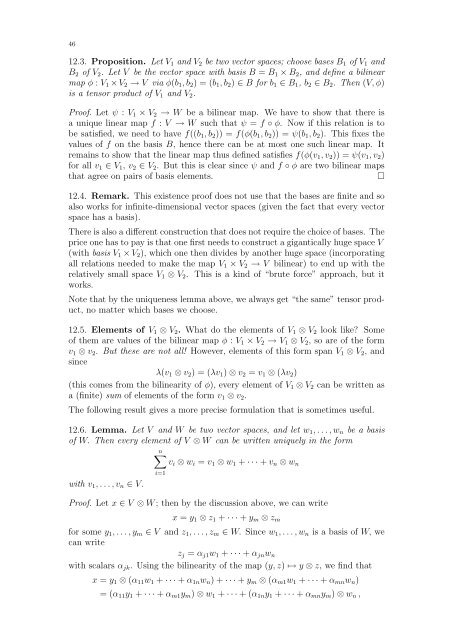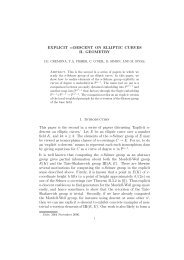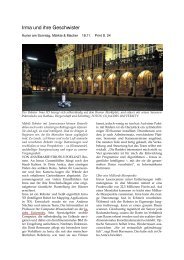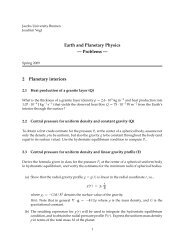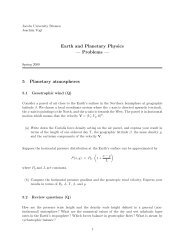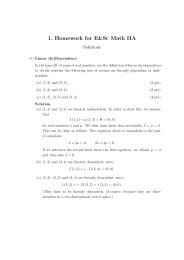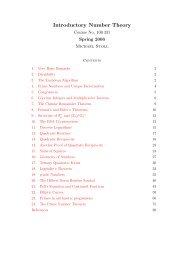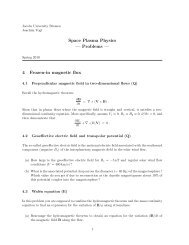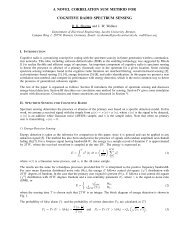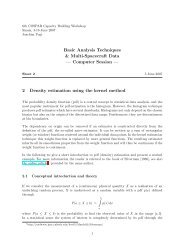Linear Algebra II (pdf, 500 kB)
Linear Algebra II (pdf, 500 kB)
Linear Algebra II (pdf, 500 kB)
You also want an ePaper? Increase the reach of your titles
YUMPU automatically turns print PDFs into web optimized ePapers that Google loves.
46<br />
12.3. Proposition. Let V1 and V2 be two vector spaces; choose bases B1 of V1 and<br />
B2 of V2. Let V be the vector space with basis B = B1 × B2, and define a bilinear<br />
map φ : V1 × V2 → V via φ(b1, b2) = (b1, b2) ∈ B for b1 ∈ B1, b2 ∈ B2. Then (V, φ)<br />
is a tensor product of V1 and V2.<br />
Proof. Let ψ : V1 × V2 → W be a bilinear map. We have to show that there is<br />
a unique linear map f : V → W such that ψ = f ◦ φ. Now if this relation is to<br />
be satisfied, we need to have f((b1, b2)) = f(φ(b1, b2)) = ψ(b1, b2). This fixes the<br />
values of f on the basis B, hence there can be at most one such linear map. It<br />
remains to show that the linear map thus defined satisfies f(φ(v1, v2)) = ψ(v1, v2)<br />
for all v1 ∈ V1, v2 ∈ V2. But this is clear since ψ and f ◦ φ are two bilinear maps<br />
that agree on pairs of basis elements. <br />
12.4. Remark. This existence proof does not use that the bases are finite and so<br />
also works for infinite-dimensional vector spaces (given the fact that every vector<br />
space has a basis).<br />
There is also a different construction that does not require the choice of bases. The<br />
price one has to pay is that one first needs to construct a gigantically huge space V<br />
(with basis V1 × V2), which one then divides by another huge space (incorporating<br />
all relations needed to make the map V1 × V2 → V bilinear) to end up with the<br />
relatively small space V1 ⊗ V2. This is a kind of “brute force” approach, but it<br />
works.<br />
Note that by the uniqueness lemma above, we always get “the same” tensor product,<br />
no matter which bases we choose.<br />
12.5. Elements of V1 ⊗ V2. What do the elements of V1 ⊗ V2 look like? Some<br />
of them are values of the bilinear map φ : V1 × V2 → V1 ⊗ V2, so are of the form<br />
v1 ⊗ v2. But these are not all! However, elements of this form span V1 ⊗ V2, and<br />
since<br />
λ(v1 ⊗ v2) = (λv1) ⊗ v2 = v1 ⊗ (λv2)<br />
(this comes from the bilinearity of φ), every element of V1 ⊗ V2 can be written as<br />
a (finite) sum of elements of the form v1 ⊗ v2.<br />
The following result gives a more precise formulation that is sometimes useful.<br />
12.6. Lemma. Let V and W be two vector spaces, and let w1, . . . , wn be a basis<br />
of W. Then every element of V ⊗ W can be written uniquely in the form<br />
n<br />
with v1, . . . , vn ∈ V.<br />
i=1<br />
vi ⊗ wi = v1 ⊗ w1 + · · · + vn ⊗ wn<br />
Proof. Let x ∈ V ⊗ W ; then by the discussion above, we can write<br />
x = y1 ⊗ z1 + · · · + ym ⊗ zm<br />
for some y1, . . . , ym ∈ V and z1, . . . , zm ∈ W. Since w1, . . . , wn is a basis of W, we<br />
can write<br />
zj = αj1w1 + · · · + αjnwn<br />
with scalars αjk. Using the bilinearity of the map (y, z) ↦→ y ⊗ z, we find that<br />
x = y1 ⊗ (α11w1 + · · · + α1nwn) + · · · + ym ⊗ (αm1w1 + · · · + αmnwn)<br />
= (α11y1 + · · · + αm1ym) ⊗ w1 + · · · + (α1ny1 + · · · + αmnym) ⊗ wn ,


